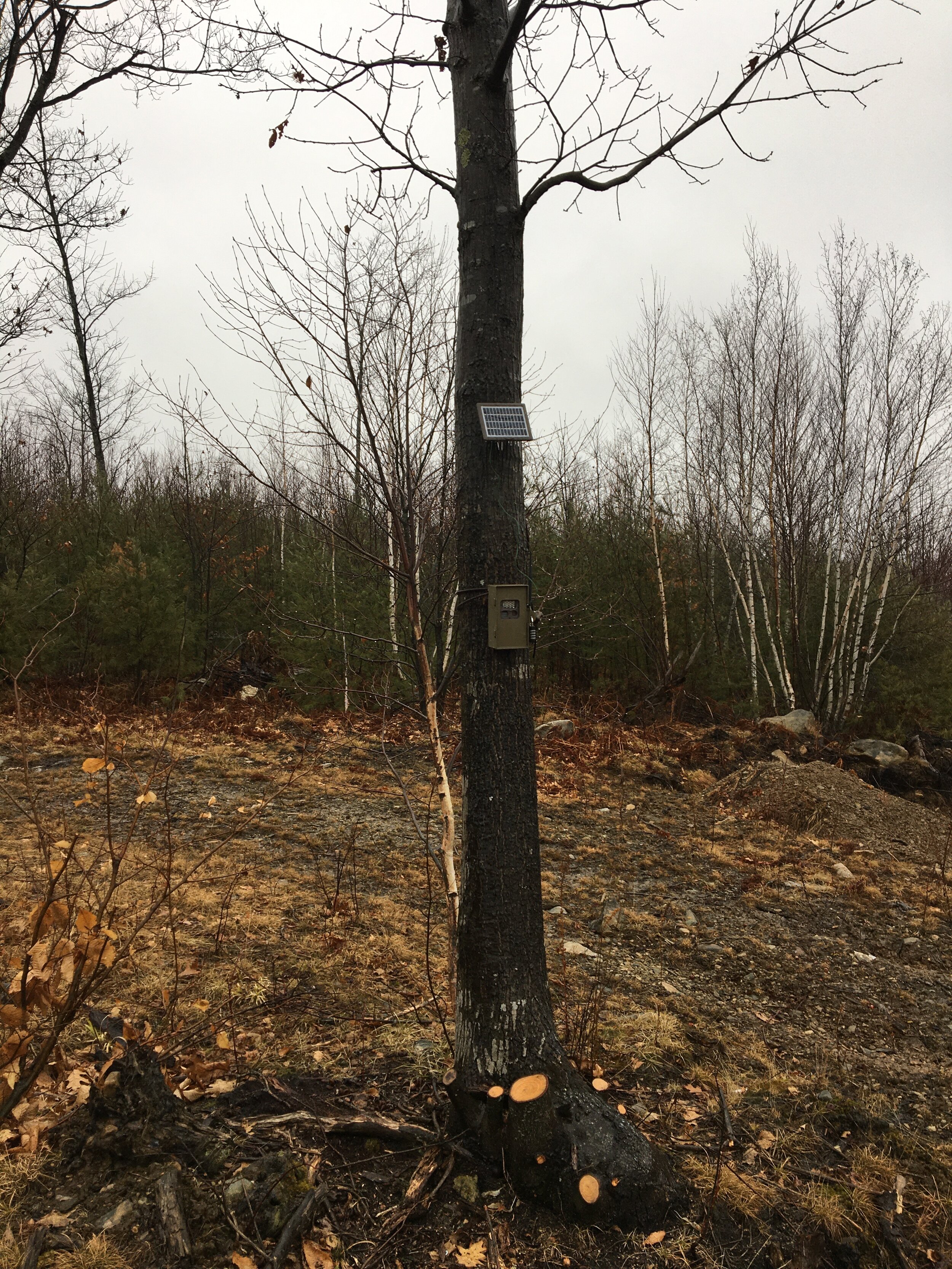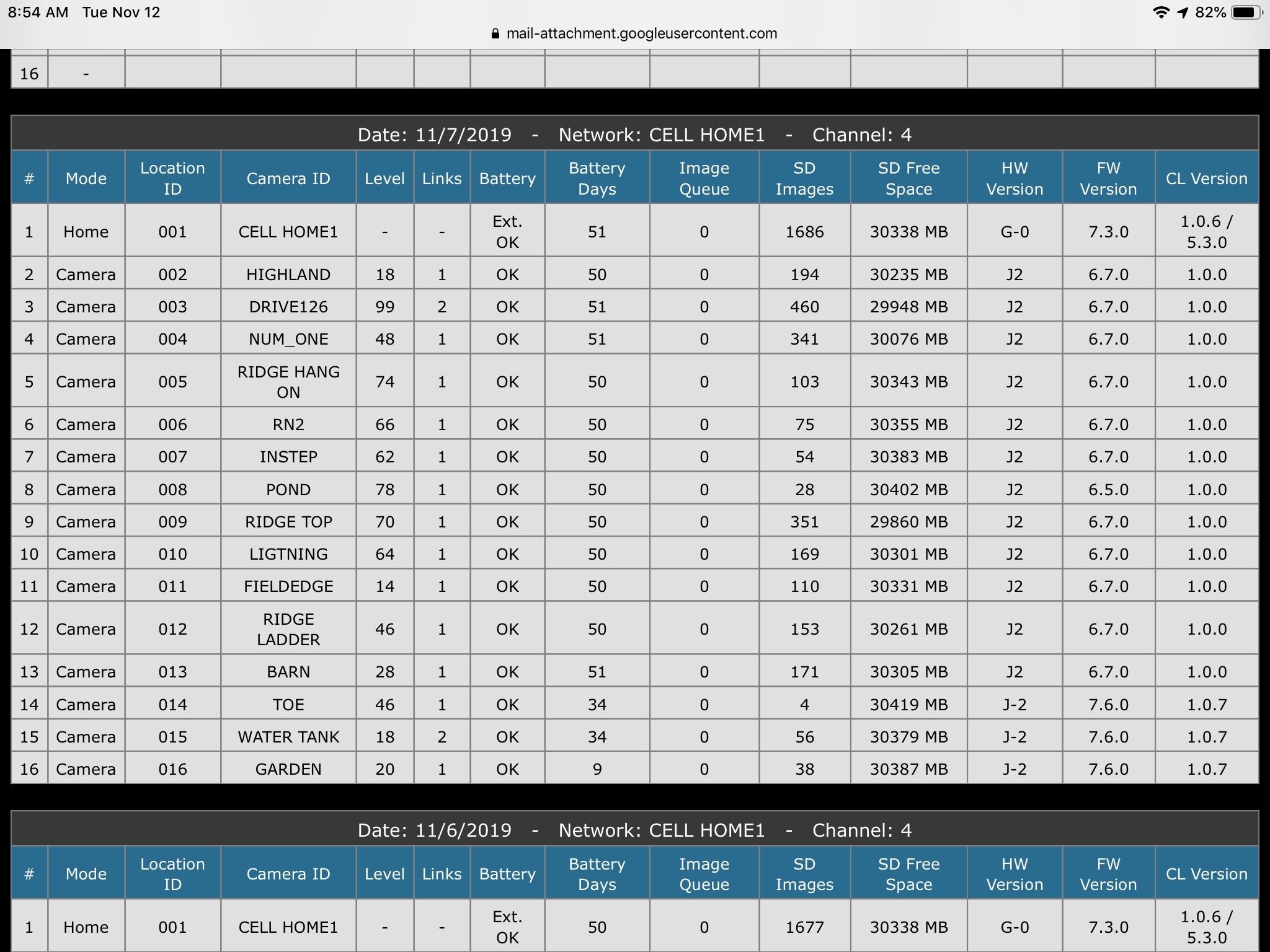Cuddeback CuddeLink Cell
Review Date: April 2020
My first trail camera was a Christmas present, probably 20 years ago, and it had a brilliant white flash. That winter I put it on a pile of corn in the field below my house, and I could see it from my bedroom - the white flash lighting up the woods on a snowy winter night, deer caught frozen in the light. Judging by the photos, the flash of visible light definitely spooked them.
Over the years I’ve tried several brands of game cameras, and had varying results. I found Reconyx to be the highest quality, also the highest price, and Browning to be the best value, but there are dozens of makes and models I didn’t try and I’m sure many good options. Other than that first one, my cameras all have infrared light which doesn’t seem to bother the deer, especially if you mount the camera higher on the tree. As of 2019, most trail cameras save their photos to memory cards and you have to physically go to the cameras to see what’s on the cards. This means that you are constantly out there where you are hunting, during the season, swapping cards, and leaving your scent on the camera and in the field. It is very hard to run multiple cameras and get a good idea of where the deer are without spooking them.
J-1415 camera with solar panel and security box
Several years ago I read about a new camera system being introduced by Cuddeback that would allow you to link multiple cameras together wirelessly, and only have to pull the card from the one “home” camera. This was very interesting, but I waited a year until the first reviews came out so I could get an idea of how it worked. The buzz was positive, so in 2018 I jumped in and bought a bunch of their model J-1415 long range IR flash cameras and linked them together. I knew going in that this would be a commitment, that I would be switching over to a system of interlinked cameras, and that I would be investing in a lot of new equipment.
The food plot located at the north end of my land close to the barn gets good deer traffic in the afternoon and at night and I’ve always had a camera there. When I deployed the CuddeLink system I made the Barn plot camera the home camera, and located “remote” cameras throughout my land in spots where I wanted to see what was happening. The total distance from the north to the south is almost a mile, and photos from the farthest camera were transmitted along the daisy chain, camera to camera, all the way back to the home camera at the Barn plot.
I believe in locating cameras six to nine feet off the ground so they won’t be noticed by deer and, whenever possible, I locate the cameras where I can back the Ranger up to their tree and service them by standing on the ATV bed. Every few days I backed the Ranger up to the telephone pole in the Barn plot and swapped the memory card out so I could review the photos on my home laptop. To collect the photos from a dozen cameras I only needed to go to the one “home” camera, and my feet never even touched the ground! I was now able to get current photos without visiting remote cameras and leaving my scent.
The new home cell unit collects photos and uploads them to an email
As you deploy cameras you check the strength of the signal between that camera and the next in the chain, so you always know how strong your system is. During that first year I noticed that the central rocky ridge on my original 61 acres was degrading the signal in the middle of my daisy chain, so I added one remote camera to act as a repeater from the top of the ridge. I put the camera at an open spot where an old logging trail went over the ridge, but it didn’t have a lot of sign or look particularly interesting - oh, how I was wrong! Immediately I started getting photos of a pair of mature bucks that were frequenting that spot, and they were there in daylight! I wasn’t set up to hunt that area, but at least I knew they were there.
The land management pages on this website from 2018 and 2019 outline how I used my Cuddeback CuddeLink system to direct when and where I hunt. What is not really explored is how the lack of photos in some places caused me not to hunt those areas. In 2018 I had cut the north/south trail on the west side of my land, and located a tree stand along the trail, with the expectation of hunting a part of my land that should be good. I had even found a buck bed and a large shed while cutting the trail, placed a camera along the trail, and had pre-season photos of nice bucks using it in August. But when the season came around in September the bucks stopped coming by the stand and I never hunted it.
Home unit, battery pack, and solar panel located high in a tree on the top of the ridge
In 2019 I located a Redneck box blind at the top of the ridge so I could hunt the bucks I’d had on camera there in 2018, but all the cutting must have caused them to change their habits and the CuddeLink camera got nothing - based on the lack of photos, I never hunted that blind and plan to move it this year. Using regular cameras I would never have been sure whether or not my visits to swap cards would have been the reason those bucks moved on. The north/south trail is an example of a camera location that was remote, with branches hanging down, tall weeds, shooting lanes, and the tree stand looking down on the trail from 25 yards away - there would have been no way to get down to where the camera was and swap cards without leaving my scent.
As first designed, CuddeLink required me to visit the home camera whenever I wanted to see photos, so when they came out with an integrated cell option that would email the photos I jumped on that as well. To convert my existing system to CuddeLink Cell, all I needed to do was add a cell-linked home base. I selected a tree near the top of the ridge, and used a ladder to locate the home unit high up in the tree, along with a battery pack and a solar panel. The J-1415 cameras had been running about 90 days on a set of lithium batteries, but Cuddeback claimed that adding a solar panel would extend that to a couple years or more. I didn’t want to schlep a ladder out to the home base tree very often, and I’m out of state for 4 months during the winter, so the solar power would keep the system running year-round with zero maintenance.
A daily report is emailed to me showing the status of each camera
During the 2019 hunting season I had 15 remote cameras located around my 108 acres, covering an area that’s about a mile from north to south. Every night at 4:00 AM I receive a report and photos by email - and I can get that email anywhere in the world. The photos are all those sent by the remote cameras to the home base in the 24 hours prior to 4:00 AM, and the report details each camera’s status.
My system is full - it only allows the 16 components of cameras and home base - and I’m thinking about creating another system so I can add more cameras. I bought the cameras from Amazon (a four-pack for around $700) and the cost of the Verison cell account is $21.10 per month.
So how do I like the Cuddeback CuddeLink Cell system? I like it a lot. I wouldn’t say that the cameras are the absolute best trail cameras available, but they are good. The quality of the daytime photos is very good, and the nighttime IR photos gives you everything you need to identify the deer.
No tree? Make your own!
The real benefit of the system is the ability to get photos every day from a large number of cameras, emailed to me, at a reasonable price, without ever having to go into the woods. I have confidence that my camera system is not spooking deer and that I’m getting the most recent information available. Cuddeback says that the cameras will communicate up to 1/4 mile in woods and a mile in open terrain, and this seems right to me - I haven’t had any real problems getting the cameras to communicate.
What don’t I love about the system? Unlike every other camera I own, the Cuddeback’s I have do not have a way to be locked to a tree - usually there’s a built-in hole that a Master Python lock goes through, but not with the Cuddebacks I own. Maybe it’s not a problem for cameras located deep in the woods, but my land is in the suburbs and there are people around. So to keep each camera from being stolen I have to go to Custom1 Enterprises and buy a steel security box for $30. That adds up.
The range of the motion detection also seems to be an issue. Some of my other cameras capture deer movement farther away than the Cuddebacks. And maybe the detection field is narrow - I had 10 does come into a food plot and the camera was directly below the stand from which I shot one of them, but the only photo I got was me leaving the stand. With any camera you’re going to miss stuff, and I will continue to add more cameras to be sure I’m covering as much as possible, but my complaint with this system is really that the cameras could be better.
You don’t have to be around to get some cool photos
I have had four cameras out all winter, powered by solar panels, so I can keep an eye on the barn and trespassers. It’s been fun to see people passing by on the power lines, or the snow falling off the barn’s metal roof. I’m planning to add solar panels to many of my existing cameras and leave them out year-round so I can get more photos - why bring them in? In the spots where I don’t have a tree with good sunlight, I bury a pressure treated 2x4 in the ground with a piece of scrap metal at the bottom to function as a deadman, and a chain leading up from it to lock to the camera. Someone would have to really work to rip it out of the ground. All summer and through next winter I’ll have plenty of photos to look at!






